The Gneelivaneswarar temple in Thirupainjeeli, is named after 'Gneeli', a variety of banana tree, with "paingneeli" meaning "green banana" in the local language. Upon approaching the temple, visitors first encounter an unfinished, truncated tower marking the initial entrance. Passing through the gate of this first tower leads to a 'mandapam' or enclosure supported by four pillars. Behind this stands an impressive second tower, rising three levels high, and this entrance is known as 'Ravana Vayil'. To the left of 'Ravana Vayil' is the revered Chotrudai Ishwarar sannidhi. According to the temple's Sthala Purana, God Shiva took the form of an 'Andanan'; (a priest or Brahmin, often associated with Vedic practices) and offered food to Tirunavukkarasar, guided him to the Thirupaigneeli temple, and finally revealed himself to Thirunavukkarasar as a Shiva Linga. That very Shiva Linga is enshrined and worshipped in the Chotrudai Ishwarar sannidhi to this day. Every year on the auspicious day when the star Avittam aligns with the month of Chithirai in the tamil calendar, the temple celebrates the event of God Shiva feeding and guiding Tirunavukkarasar to Tirupaingneeli.
The sannidhi for Yama, the god of death, is located in a rock-cut underground cave along the outer prakaram (circumambulating pathway) of the temple, just before entering through the Ravana Vayil. Inside this unique subterranean shrine, Muruga as Soma Skanda is situated between his divine parents Shiva and Parvati, with a diminutive form of Yama as a child positioned at the foot of Shiva. As in Tirukadavur, important rituals such as the 60th birthday milestone celebration known as Shashti Abtha Poorthy and the life-prolonging ceremony of Ayull Vruddhi Homa are performed in front of this subterranean sannidhi. The backstory behind this depiction harks back to the legend of Markandeya, whom Shiva saved from the clutches of death by forcefully subduing Yama. However, this act of divine intervention disrupted the natural cycle of life and death, causing an unsustainable increase in the world's population that burdened the earth goddess Bhumi Devi. Beseeched by Bhumi Devi and the celestial deities to restore balance, Shiva mercifully revived Yama in the form of a child at this sacred spot, entrusting him with the vital task of regulating mortality in accordance with the principles of dharma and righteousness. Thus, this sannidhi serves as a powerful reminder of the delicate equilibrium between life and death, and the crucial role that Yama plays in maintaining the cosmic order under the benevolent guidance of Shiva.
The Tirupaingneeli temple, exhibits a unique feature in its lack of a dedicated sannidhi, or shrine, for the Navagrahas - the nine planetary deities typically revered in temples. This notable absence is attributed to the presence of a sannidhi specifically consecrated to Yama, the deity governing death and the afterlife, who holds the esteemed position of being the head of Saneeshwara, the celestial figure associated with Saturn. Interestingly, the path leading from the "Ravana Vail," an entrance named after the legendary demon king Ravana, to the temple's central sanctum necessitates a descent of nine steps. These steps are imbued with profound symbolism, as they are believed to represent the nine planetary deities who, according to mythological accounts, were once held captive by Ravana himself. In a fascinating ritual, devotees pay homage to the Navagrahas by pouring ghee or oil into nine small holes strategically placed beside the Nandi, the sacred bull that is a constant companion of Lord Shiva, situated directly in front of the main sanctum. The act of lighting lamps in these holes and offering prayers to them as embodiments of the Navagrahas highlights the ways in which this temple incorporates the veneration of these celestial beings, even in the absence of a traditional sannidhi dedicated to them.
The sanctum of the Gneelivaneswarar Temple, which houses the self-manifested Shiva Linga of the presiding deity Gneelivaneswarar, is accessed by passing through two gateways - the second tower known as 'Ravana Vayil' and another entrance called 'Tirukarthikai Vayil'. Gneelivaneswarar, who is also reverentially referred to as 'Athikara Vallabar', earned this title by compassionately reviving Yama, the God of Death, and granting him the divine authority to continue his sacred duty of overseeing the departure of souls from the mortal realm. This ancient temple has been a site of immense spiritual significance, attracting devotees and celestial beings alike. It is believed that Mahavishnu, the divine cow Kamadhenu, the serpent king Adhishesha, Vayu the Wind God, Agni the Fire God, Rama, the valiant warrior Arjuna, and the illustrious sage Vasishta have all offered their fervent prayers and received the grace and blessings of Gneelivaneswarar. The main sanctum also houses the resplendent Rathna Sabha, where Shiva is said to have performed his mesmerizing Cosmic Dance at the earnest request of Sage Vasishta. This sacred space, is also known as 'Mela Chidambaram', drawing parallels to the renowned Chidambaram Temple, which is similarly revered for its association with Shiva's Cosmic Dance.
Within this temple complex, there are two distinct sannidhis where the Goddess is worshipped in her divine form as Visalakshi. According to ancient lore, Devi Parvathy once sought to engage in the profound practice of Shiva Yoga, a meditative discipline focused on attaining unity with Shiva. In her quest for enlightenment, she selected this hallowed location as the ideal setting for her spiritual pursuits. However, upon arriving at the chosen spot, Devi Parvathy observed a scarcity of trees that would provide the necessary shade for her meditative practice. she transformed the seven celestial maidens, known as the Saptha Kannika, who had accompanied her to assist in her spiritual journey, into majestic Gneeli trees. It is believed that worshipping these revered trees with sincere devotion and pure intentions can lead to the fulfillment of one's desires, particularly those related to a successful and harmonious marriage. To facilitate this spiritual practice, the temple authorities have established specific times for conducting remedial pujas dedicated to the Gneeli trees. These auspicious rituals are performed on Fridays and Sundays, with morning sessions held from 8:30 am to 12:30 pm and evening sessions from 4:30 pm to 5:30 pm.
The hagiography of the Nayanar saint Tirunavukkarasar, also known as Appar, includes a remarkable account of divine intervention during his pilgrimage to sacred Shaivite sites in the 7th century CE. According to this traditional narrative, after Tirunavukkarasar had visited the temples at Tiru-Chira-Palli, Tiru-Karkudi, and Tiruparaithurai, he set out on the road to Tirupaingneeli, driven by his fervent devotion despite the fatigue of his arduous journey. Cognizant of his devotee's plight, Shiva elected to miraculously alleviate Tirunavukkarasar's hunger and thirst, manifesting a tranquil body of water and a sheltered resting place along the route. The god then assumed the form of an 'Andhanan', and awaited the saint's arrival with parcels of food. Upon reaching this waypoint, Tirunavukkarasar humbly accepted the 'Andhanan's offer and, at his benefactor's behest, paused to partake of the meal and quench his thirst at the newly formed pond before continuing on his way, reinvigorated in body and spirit. When Tirunavukkarasar inquired as to his benefactor's own destination, he replied that he too was bound for Tirupaingneeli; the pair then proceeded together toward their destination until, as they reached the outskirts of the town, Tirunavukkarasar's mysterious companion suddenly vanished from sight. In that moment, the saint experienced a profound revelation, recognizing that his fellow traveler had been none other than Shiva himself, who, in his infinite compassion and grace, had deigned to provide sustenance and companionship to Tirunavukkarasar.
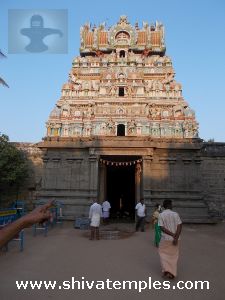 3 Tiered Gopuram
3 Tiered Gopuram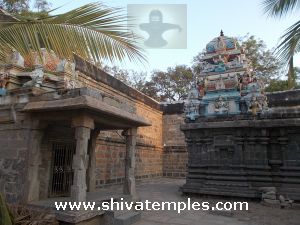 Inside View
Inside View Sacred Tree
Sacred Tree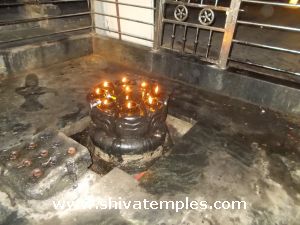 The nine holes, Navagraha Deepam
The nine holes, Navagraha Deepam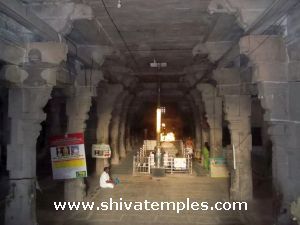 Another View
Another View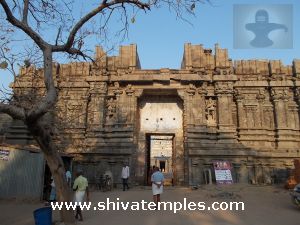 Truncated Tower
Truncated Tower